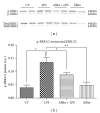Alliin, a garlic (Allium sativum) compound, prevents LPS-induced inflammation in 3T3-L1 adipocytes
- PMID: 24453416
- PMCID: PMC3888727
- DOI: 10.1155/2013/381815
Alliin, a garlic (Allium sativum) compound, prevents LPS-induced inflammation in 3T3-L1 adipocytes
Abstract
Garlic (Allium sativum L.) has been used to alleviate a variety of health problems due to its high content of organosulfur compounds and antioxidant activity. The main active component is alliin (S-allyl cysteine sulfoxide), a potent antioxidant with cardioprotective and neuroprotective actions. In addition, it helps to decrease serum levels of glucose, insulin, triglycerides, and uric acid, as well as insulin resistance, and reduces cytokine levels. However its potential anti-inflammatory effect is unknown. We examined the effects of alliin in lipopolysaccharide- (LPS-) stimulated 3T3-L1 adipocytes by RT-PCR, Western blot, and microarrays analysis of 22,000 genes. Incubation of cells for 24 h with 100 μmol/L alliin prevented the increase in the expression of proinflammatory genes, IL-6, MCP-1, and Egr-1 in 3T3-L1 adipocytes exposed to 100 ng/mL LPS for 1 h. Interestingly, the phosphorylation of ERK1/2, which is involved in LPS-induced inflammation in adipocytes, was decreased following alliin treatment. Furthermore, the gene expression profile by microarrays evidentiate an upregulation of genes involved in immune response and downregulation of genes related with cancer. The present results have shown that alliin is able to suppress the LPS inflammatory signals by generating an anti-inflammatory gene expression profile and by modifying adipocyte metabolic profile.
Figures




References
-
- Kawada T, Takahashi N, Fushiki T. Biochemical and physiological characteristics of fat cell. Journal of Nutritional Science and Vitaminology. 2001;47(1):1–12. - PubMed
-
- de Heredia FP, Gómez-Martínez S, Marcos A. Obesity, inflammation and the immune system. Proceedings of the Nutrition Society. 2012;71(2):332–338. - PubMed
-
- Kershaw EE, Flier JS. Adipose tissue as an endocrine organ. Journal of Clinical Endocrinology and Metabolism. 2004;89(6):2548–2556. - PubMed
-
- Trayhurn P, Wood IS. Signalling role of adipose tissue: adipokines and inflammation in obesity. Biochemical Society Transactions. 2005;33(5):1078–1081. - PubMed
-
- Ferrante AW., Jr. Obesity-induced inflammation: a metabolic dialogue in the language of inflammation. Journal of Internal Medicine. 2007;262(4):408–414. - PubMed
Publication types
MeSH terms
Substances
LinkOut - more resources
Full Text Sources
Other Literature Sources
Miscellaneous

